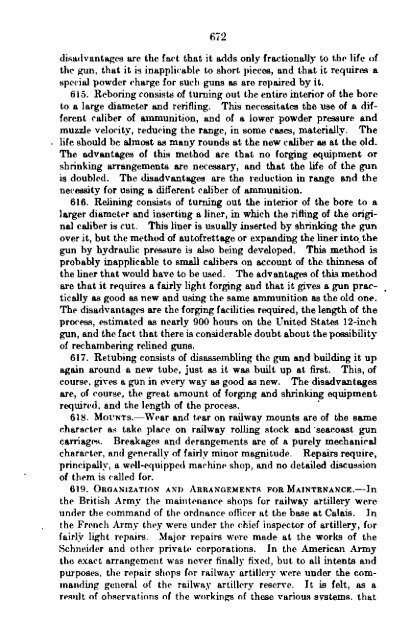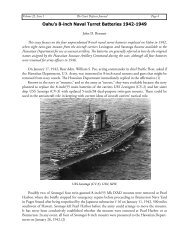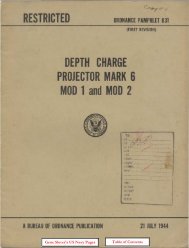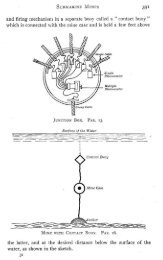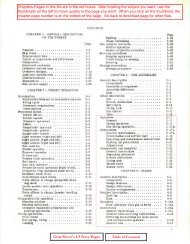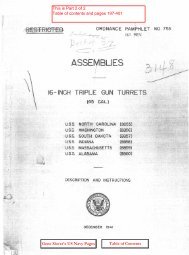...Railway artillery - Personal Page of GENE SLOVER
...Railway artillery - Personal Page of GENE SLOVER
...Railway artillery - Personal Page of GENE SLOVER
You also want an ePaper? Increase the reach of your titles
YUMPU automatically turns print PDFs into web optimized ePapers that Google loves.
672<br />
disadvantages are the fact that it adds only fractionally to the life <strong>of</strong><br />
tho gun, that it is inapplicable to short pieces, and that it requires a<br />
spodal powder charge for such guns as are repaired by it.<br />
615. Reboring consists <strong>of</strong> turning out the entire interior <strong>of</strong> the bore<br />
to a large diameter and rerifting. This necessitates the use <strong>of</strong> a different<br />
caliber <strong>of</strong> ammunition, and <strong>of</strong> a lower powder pressure and<br />
muzzle velocity, reducing the range, in some cases, materially. The<br />
life should be almost as many rounds at the new caliber as at the old.<br />
The advantages <strong>of</strong> this method are that no forging equipment or<br />
shrinking arrangements are necessary, and that the life <strong>of</strong> the gun<br />
is doubled. The disadvantages are the reduction in range and the<br />
necessity for using a different caliber <strong>of</strong> ammunition.<br />
616. Relining consists <strong>of</strong> turning out the interior <strong>of</strong> the bore to a<br />
larger diameter and inserting a liner, in which the rifling <strong>of</strong> the original<br />
caliber is cut. This liner is usually inserted by shrinking the gun<br />
over it, but the method <strong>of</strong> aut<strong>of</strong>rettage or expanding the liner into. the<br />
gun by hydraulic pressure is also being developed. This method is<br />
probably inapplicable to small calibers on account <strong>of</strong> the thinness <strong>of</strong><br />
the liner that would have to be used. The advantages <strong>of</strong> this method<br />
are that it requires a fairly light forging and that it gives a gun pra.c- •<br />
tic ally as good as new and using the same ammunition as the old one.<br />
The disadvantages are the forging facilities required, the length <strong>of</strong> the<br />
process, estimated as nearly 900 hours on the United States 12-inch<br />
gun, and the fact that there is considerable doubt about the possibility<br />
<strong>of</strong> rechambering relined guns.<br />
617. Retubing consists <strong>of</strong> disassembling the gun and building it up<br />
again around a new tube, just as it was built up at first. This, <strong>of</strong><br />
course, gives a gun in every way as good as new. The disadvantages<br />
are, <strong>of</strong> course, the great amount <strong>of</strong> forging and shrinking equipment<br />
required, and the length <strong>of</strong> the process. .<br />
618. MOUNTs.-Wear and tear on railway mounts are <strong>of</strong> the same<br />
character a" take place on railway rolling stock and 'seacoast gun<br />
carriages. Breakages and derangements are <strong>of</strong> a purely mechanical<br />
character, and generally <strong>of</strong> fairly minor magnitude. Repairs require,<br />
principally, a well-equipped machine shop, and no detailed discussion<br />
<strong>of</strong> them is called for.<br />
619. ORGANIZATION AND ARRANGEMENTS FOR MAINTENANcE.-In<br />
the British Army the maintenance shops for railway <strong>artillery</strong> were<br />
under the command <strong>of</strong> the ordnance <strong>of</strong>ficer at the base at Calais. In<br />
the French Army they were under the chief inspector <strong>of</strong> <strong>artillery</strong>, for<br />
fairly light repairs. Major repairs were made at the works <strong>of</strong> the<br />
Schneider and other private corporations. In the American Army<br />
the exact arrangement was never finally fixed, but to all intents and<br />
purposes, the repair shops for railway <strong>artillery</strong> were under the commanding<br />
general <strong>of</strong> the railway <strong>artillery</strong> reserve. It is felt, as a<br />
r1'9111t <strong>of</strong> observat.ions <strong>of</strong> the workings <strong>of</strong> these various sYStems. that<br />
Digitized by Coogle


